标签:用户创建 cmd 模糊查询 tac src ges 通过 博客 自增
上课第三天,打卡:
不要让干净的灵魂染上尘埃,永远年轻、永远热泪盈眶
‘文件‘ 是一个抽象的概念,是操作系统提供的外部存储设备的抽象,对应底层的硬盘;它是程序和数据的最终存放地点。
操作系统把硬盘存储的具体操作封装起来,提供一些简单易用的API,让用户不用去关心底层复杂的实现方法;
即:让用户的数据存放变得容易、方便和可靠。
另外,磁盘没有 ‘修改‘ 一说,全部都是覆盖;
> 备注:这段精辟的解释来自于 林海峰老师的博客 , 解释的清晰明了,向老师致敬!
Unicode:简单粗暴,所有字符都用2Bytes表示,优点是 字符->数字(二进制) 的转换速度快,缺点是占用空间大;
utf-8:精准,对不同的字符采用不同的长度表示,优点是节省空间,缺点是:字符->数字(二进制) 的转换速度慢,因为每次都需要计算出字符需要多长的Bytes才能够准确表示;
内存中使用的编码是unicode,硬盘中或者网络传输用utf-8(这也就涉及到了大端序和小端序的问题)
为什么呢?
所有程序,最终都要加载到内存,程序保存到硬盘(不同的国家用不同的编码格式),但是到内存中我们为了兼容万国(计算机可以运行任何国家的程序原因在于此),统一且固定使用unicode,这就是为何内存固定用unicode的原因;你可能会说兼容万国我可以用utf-8啊,可以,完全可以正常工作,之所以不用肯定是unicode比utf-8更高效啊(uicode固定用2个字节编码,utf-8则需要计算),但是unicode更浪费空间,没错,这就是用空间换时间的一种做法;
而存放到硬盘(考虑节省空间),或者网络传输(考虑速度快),都需要把unicode转成utf-8;因为数据的传输,追求的是稳定,高效,数据量越小数据传输就越靠谱,于是都转成utf-8格式的,而不是unicode。
所以:
内存中使用的编码是unicode,用空间换时间(程序都需要加载到内存才能运行,因而内存应该是尽可能的保证快)。
硬盘中或者网络传输用utf-8,网络I/O延迟或磁盘I/O延迟要远大与utf-8的转换延迟,而且I/O应该是尽可能地节省带宽,保证数据传输的稳定性。
内存 -> 磁盘:用户创建一个新文件,写入一些数据,然后 [ctrl+s/esc+:+wq] 存储到磁盘上,关闭文件;
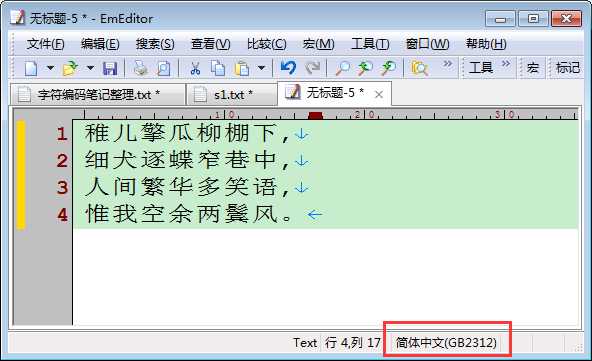
- 新建一个文件,写入数据 --> 这个操作是在内存中进行的,跟磁盘无关;此时,写的这些数据都在内存中以Unicode编码格式存储;
- ctrl+s 保存 --> 这个操作是把这些数据写到了本地硬盘上;既然存储到硬盘,就必定按照某种编码格式存储,即右下角显示的 GB2312;
这就存在一个数据从内存到硬盘的编码转换问题:本例中即从内存的Unicode格式的二进制 转换成 硬盘中的GB2312的二进制格式进行存储;
磁盘 -> 内存:用户打开文件,在界面上显示数据;
- 再次打开这个文件,原来的数据显示在页面上 --> 这个操作就是把数据从硬盘上读到了内存中;同样也是存在一个编码转换的问题:
从硬盘的GB2312格式的二进制 转换成 内存的Unicode格式的二进制进行存储并显示到EmEditor上;
为什么显示的时候没有出现乱码呢?
这就要看EmEditor是按照什么编码进行打开的了:
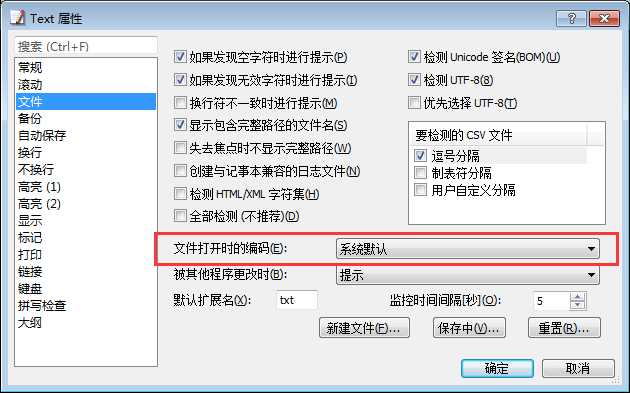
很明显,是按照系统默认编码进行打开文件的,那么问题又来了,系统默认编码是什么呢?
打开cmd,输入chcp,回车:
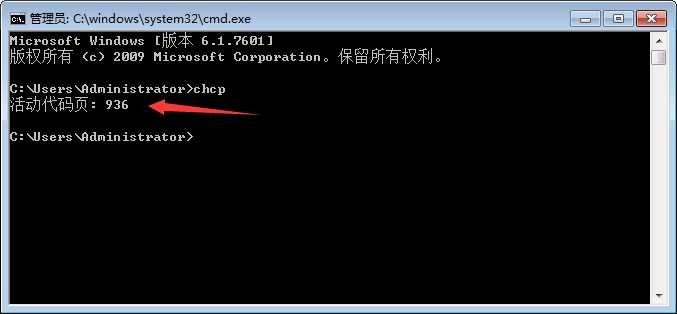
附上几个常用国家的活动代码页对照表:
1 代码页 国家(地区)或语言 2 437 美国 3 866 俄语 - 西里尔文(DOS) 4 932 日文(Shift-JIS) 5 936 中国 - 简体中文(GB2312) 6 950 繁体中文(Big5) 7 1200 Unicode 8 1201 Unicode (Big-Endian) 9 50000 用户定义的 10 50001 自动选择 11 52936 简体中文(HZ) 12 65000 Unicode (UTF-7) 13 65001 Unicode (UTF-8)
很明显:EmEditor按照系统默认编码打开文件,而默认编码是936,即 ‘中国 - 简体中文(GB2312)‘
所以这个文件存储的时候和读取的时候都是按照 GB2312编码格式进行操作的,所以必然不会出现乱码!
现在做个测试,改一下EmEditor打开文件时候的默认编码为日语(Shift-JIS),
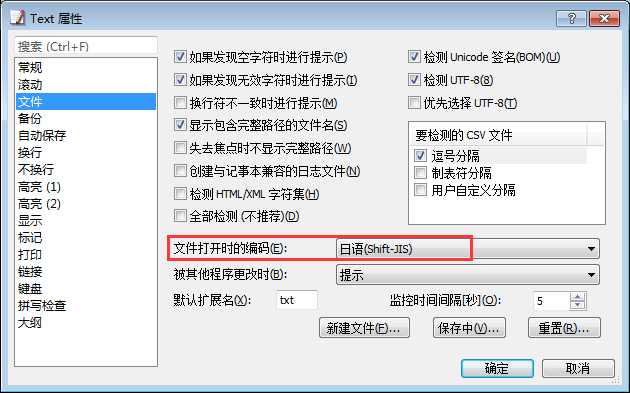
然后再用EmEditor打开这个文件看看是否会乱码:
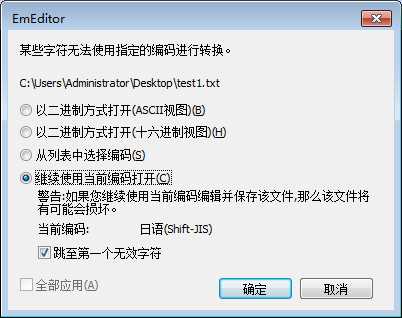
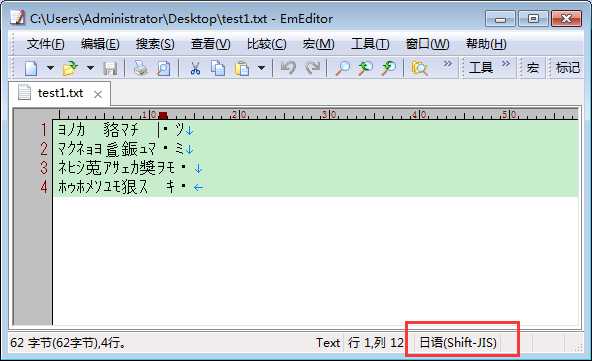
所以,只要保证写入磁盘时候用的编码和读取文件显示的时候用的编码是一样的,就不会出现乱码!
附上磁盘和内存之间转换编码的示意图:
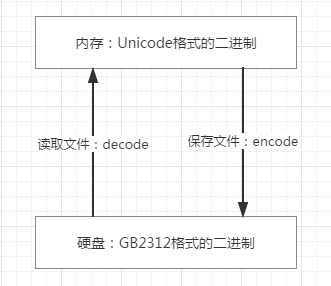
- 扩展
- python3 解释器是怎么识别自己的数据类型的?
- 它必须知道他们存储的编码类型,Python3中,所有的字符串在内存中都被识别成 Unicode编码进行存储;
- 数据在硬盘存储的时候是一种编码格式,在执行的时候也可能会产生其他编码格式;
举个小例子:
1 #!/usr/bin/python 2 # -*- coding:utf-8 -*- 3 4 string =‘中国‘ 5 print(string) 6 7 str2 = string.encode(‘utf-8‘) # python 3.5 8 # str2 = string.decode(‘utf-8‘) # python 2.7 9 print(str2) 10 11 str3 = str2.decode(‘utf-8‘) 12 print(str3) 13 14 --- 15 中国 16 b‘\xe4\xb8\xad\xe5\x9b\xbd‘ 17 中国
- 在Python3.5中,字符串都是以Unicode编码存储,Unicode是万国码,可以encode成任意编码格式;
- string =‘中国‘ # 这一步在执行的时候,需要开辟一个内存空间用来存储string编码之后的结果,是按照Unicode编码;打印的时候不论在什么终端都可以正确显示 ‘中国‘ , 不会乱码;
- str2 = string.encode(‘utf-8‘) # 把 string对应的字符串内容从Unicode编码转换成utf-8编码,并把转换后的结果赋值给 str2; 所以打印的时候显示的是 二进制形式的数据,即bytes; (Unicode 类型只有encode方法)
- str3 = str2.decode(‘utf-8‘) # 把str2对应的bytes类型的数据转换成Unicode类型,并把转换后的结果赋值给str3;由于解码时候也是按照 utf-8 进行解码,所以肯定不会出现乱码; (bytes 类型只有decode方法)
- 但是如果按照gbk或其他类型进行解码就会报错:
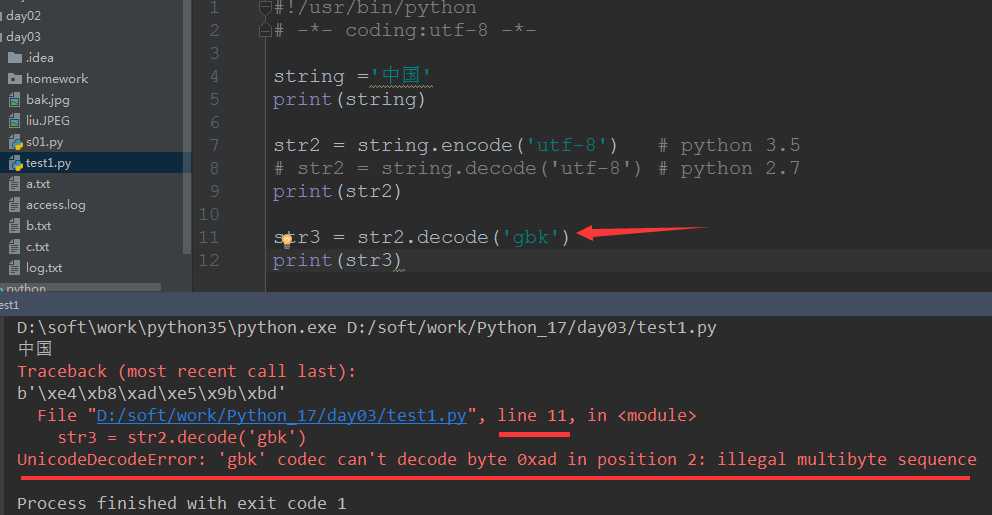
以下面这端程序为例进行说明:
1 #!/usr/bin/python 2 # -*- coding:utf-8 -*- 3 4 string =‘林‘ 5 print(string)
- 首先在pycharm里写入这几行代码的时候,所有的字符都没有任何意义,从计算机角度看,他们都是一些单纯的字符堆砌起来的并以Unicode编码存储在内种中某块区域;或者说:在文件未执行之前都是Unicode编码存在在内存中;
- 但是,在执行的时候可以人为的改变其编码形式;(例如:str2 = string.encode(‘utf-8‘) #Python 3中,这一行指定了按照utf-8进行编码格式存储,打印出来就是bytes类型)
- 在用Python解释器执行的时候,代码里的字符串才会有其特殊的意义(对象):
- string =‘林‘ # 执行到这一行,才会把string识别成一个字符串对象,并在内存中开辟一块空间用来存储 ‘林‘ 这个字符在编码之后的结果,然后让string对象指向这个内存地址;即:Python程序在执行过程中才有 字符串 的概念;
- print(string) # 执行到这一行,Python解释器会把string这个对象对应的内存中间里存储的数据打印出来,会根据显示终端的不同、Python解释器版本不同而显示出不同的样子(乱码 / 不乱码);
- 上面这个例子在Python3和Python2中打印的结果如下:
- pycharm中都能正常显示 ‘林‘ 这个汉字:

- cmd中则会不同:
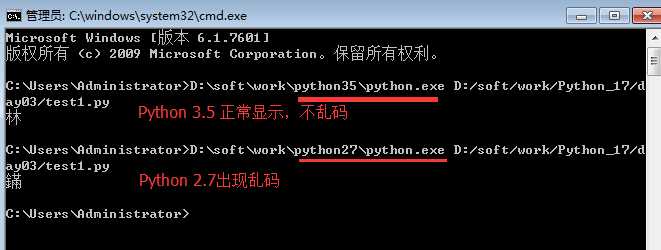
- 同样一个字符串赋值语句:string =‘林‘ ,为什么会这样呢?
- Pycharm中,不管是 Python2 还是Python3 都不乱码,是因为 Pycharm会自动识别页首的 ‘# -*- coding:utf-8 -*-‘ 从而自动改变文件的存储编码格式,保证存储编码和读取显示的编码一致,从而不乱码;
- 根据上面的测试已经知道本机Windows默认是GB2312编码,但是Windows的cmd为什么会出现乱码? 这就涉及到 Python2 和 Python3 关于字符串的定义了,见下面;
- 页首的 # -*- coding:utf-8 -*- 这个是告诉Python解释器以 utf-8 的编码去读取这个文件;
- Python3解释器默认编码是utf-8,如果页首不指定上面那一行就会按照默认的编码读取文件内容,否则就会按照页首指定的编码去读取文件内容;
- 但是,很重要的一点是:
- 默认的Python编码utf-8跟程序在执行过程中识别字符串编码是没有关系的,识别字符串是Python解释器自己数据类型的问题;
-------------------------------
- 首先明确一点:Python程序,只有在执行的过程中才有字符串的概念!
------------------------------------
- Python 3 字符串的概念
- 2种字符串类型
- str 类型,即 Unicode,所有的字符串都是以Unicode格式;(只有encode方法)
- bytes类型,即 str.encode(‘xxx‘) 之后的结果;可以通过 decode(‘xxx‘) 转换成 str类型;(只有decode方法)
1 #!/usr/bin/python 2 # -*- coding:utf-8 -*- 3 4 string =‘林‘ 5 print(type(string),string) 6 7 str1 = string.encode(‘utf-8‘) 8 print(type(str1),str1) 9 10 --- 11 <class ‘str‘> 林 12 <class ‘bytes‘> b‘\xe6\x9e\x97‘
- Python 2 字符串的概念
- 2种字符串类型
- str 类型,Python2 中,bytes 和 str 是一样:
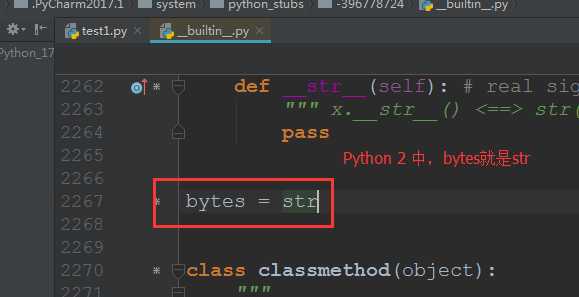
1 #!/usr/bin/python 2 # -*- coding:utf-8 -*- 3 4 string =‘林‘ 5 print type(string),repr(string) 6 str2 = string.decode(‘utf-8‘) 7 print type(str2),repr(str2) 8 9 --- 10 <type ‘str‘> ‘\xe6\x9e\x97‘ 11 <type ‘unicode‘> u‘\u6797‘
- 可以利用 repr() 函数打印出string的内容,很显然是 str类型,但内容却是 ‘\xe6\x9e\x97‘ 即bytes类型;并且string只有decode方法,encode的时候会报错;
- 也就是说,Python2执行过程中,只要碰到字符串,就会自动把字符串进行一个encode操作,得到一个字节码 bytes类型;
- 所以Python2 中的 str对象只有 decode方法;(decode成Unicode编码)
- Unicode类型,就是在赋值时候在前面加上一个 ‘u‘ : string =u‘林‘ ,这样就指定了是Unicode类型的字符串;
- 这样实际上就和Python3一样了,字符串都是Unicode;string 只有encode方法,decode会报错;
1 #!/usr/bin/python 2 # -*- coding:utf-8 -*- 3 4 string =u‘林‘ 5 print type(string),repr(string) 6 str2 = string.encode(‘utf-8‘) 7 print type(str2),repr(str2) 8 9 --- 10 <type ‘unicode‘> u‘\u6797‘ 11 <type ‘str‘> ‘\xe6\x9e\x97‘
- 解释在cmd上Python2中输出 string =‘林‘ 出现乱码的问题
- 首先却明确一点:Python2 解释器默认编码是 ascii,Python3 解释器默认编码是 utf-8;
- 这个文件的存储编码是 utf-8;
- string =‘林‘ 执行的时候 Python2 解释器 会首先读取页首的 # -*- coding:utf-8 -*- ,所以从这一行就改变了Python2默认的 ascii编码格式;
- string =‘林‘ # Python2 解释器执行这一行的时候,已经按照Python2中 str数据类型自动encode成bytes类型了,所以string存储的是encode之后的字节码(bytes);是按照页首的utf-8进行encode操作的;
- print string # Python2 解释器在Pycharm终端上执行打印操作的时候,会按照Pycharm终端的编码去解码,由于Pycharm作为一个终端,有自动识别页首 # -*- coding:utf-8 -*- 的优点,所以在Pycharm终端解码的时候也是按照utf-8格式,故不会乱码;
- print string # Python2 解释器在cmd终端上执行打印操作的时候,会按照cmd终端的编码去解码,然而由于cmd作为另一个终端,没有自动识别页首的 # -*- coding:utf-8 -*- ,所以就会按照cmd所在平台(Windows)默认的编码去解码string,由于本机Windows默认编码是 GB2312; string 是按照utf-8编码成bytes,cmd按照GB2312去解码,所以肯定会乱码;
- 解决Python2在cmd终端打印出现中文乱的方法: 在字符串赋值的时候按照 Unicode格式赋值;
- 扩展
- 对于unicode格式的数据来说,无论怎么打印,都不会乱码;
- 不管在什么终端打印,Python解释器都会按照终端的编码执行x.decode(‘终端编码‘),变成unicode后,再打印;此时终端编码若与文件开头指定的编码不一致,乱码就产生了;
- 因为程序执行是在内存中执行的,而内存编码是 Unicode, 所以一定要先转成 Unicode,再打印出来;
- CPU的两种运行状态:内核态和用户态
- OS对机器硬件有完全操作权限,但是应用程序是没有权限的,所以应用程序需要通过系统调用,即从用户态切换到内核态,从而间接操作机器硬件;
- 最常见的就是文件读写,Python写的程序运行在用户态,而只有内核态才可以操作机器的底层硬件磁盘,所以操作系统把操作方法封装成API,提供给应用程序;
- 应用程序通过系统调用(使用API),间接操作硬件;
pass
等老师把剩下那些都讲完再一起整理吧;
题目要求:
有以下员工信息表

当然此表你在文件存储时可以这样表示
1 1,Alex Li,22,13651054608,IT,2013-04-01
现需要对这个员工信息文件,实现增删改查操作
代码实现:
1 #!/usr/bin/python 2 # -*- coding:utf-8 -*- 3 import time 4 5 WARNING = "Invalid input!" 6 START = "Welcome, 1 to select, 2 to insert, 3 to update, 4 to delete, 7 q/Q to exit\n>>> " 8 user_property = [‘id‘,‘name‘,‘age‘,‘phone‘,‘job‘,‘date‘] 9 10 # Get current time, xxxx-xx-xx 11 def get_date(): 12 date = time.strftime(‘%Y-%m-%d‘, time.localtime(time.time())) 13 return date 14 15 # Get all user_info list 16 def get_all_info(): 17 user_list = [] 18 with open(‘user_info.txt‘, mode=‘r‘, encoding=‘utf-8‘) as rf: 19 data = rf.readlines() 20 if data: 21 for item in data: 22 user_dict = { 23 ‘id‘:item.split(‘|‘)[0], 24 ‘name‘:item.split(‘|‘)[1], 25 ‘age‘:item.split(‘|‘)[2], 26 ‘phone‘:item.split(‘|‘)[3], 27 ‘job‘:item.split(‘|‘)[4], 28 ‘date‘:item.split(‘|‘)[5], 29 } 30 user_list.append(user_dict) 31 return user_list 32 33 # Print all user info 34 def show_all_user_info(): 35 user_list = get_all_info() 36 for user in user_list: 37 print("{}\t{}\t{}\t{}\t{}\t{}".format(user.get(‘id‘),user.get(‘name‘),user.get(‘age‘), 38 user.get(‘phone‘),user.get(‘job‘),user.get(‘date‘)).expandtabs(20)) 39 40 # Insert a new record 41 def insert(): 42 user_info_str = input("Input user_info: name|age|phone|job >>> ") 43 user_info_list = user_info_str.split(‘|‘) 44 phone = user_info_list[2] 45 phone_list = [] 46 id_list = [] 47 if 4 == len(user_info_list): 48 user_list = get_all_info() 49 for i in range(0,len(user_list)): 50 phone_list.append(user_list[i].get(‘phone‘)) 51 id_list.append(int(user_list[i].get(‘id‘))) 52 user_info = "" 53 if len(user_list): 54 if phone not in phone_list: 55 user_info = "{}|".format(max(id_list)+1) + user_info_str + "|" + get_date() + "\n" 56 else: 57 print("The phone num has already used.") 58 else: 59 print("Init myDB ...") 60 user_info = "1|" + user_info_str + "|" + get_date() + "\n" 61 with open(‘user_info.txt‘, mode=‘a+‘, encoding=‘utf-8‘) as wf: 62 wf.write(user_info) 63 else: 64 print(WARNING) 65 66 # Delete a record 67 def delete(): 68 show_all_user_info() 69 user_list = get_all_info() 70 user_id_list = [] 71 for user in user_list: 72 user_id_list.append(user.get(‘id‘)) 73 del_id = input("Input the user_id you wanna delete >>> ") 74 if del_id not in user_id_list: 75 print("No have the user id: {}".format(del_id)) 76 else: 77 isOK = input("Are you sure to Delete user: {} ? (y/Y to del, other to exit) >>> ".format(del_id)) 78 if ‘Y‘ == isOK.upper(): 79 with open(‘user_info.txt‘, mode=‘w‘, encoding=‘utf-8‘) as wf: 80 user_info_str = "" 81 for user in user_list: 82 if del_id != user.get(‘id‘): 83 user_info_str += user.get(‘id‘) + "|" + user.get(‘name‘) + "|" + user.get(‘age‘) + 84 "|" + user.get(‘phone‘) + "|" + user.get(‘job‘) + "|" + user.get(‘date‘) 85 wf.write(user_info_str) 86 87 # Update a record 88 def update(): 89 show_all_user_info() 90 user_list = get_all_info() 91 update_cmd = input("Input update cmd >>> ") 92 cmd_list = update_cmd.split() 93 # print(cmd_list) 94 if 10 == len(cmd_list): 95 if ‘update‘ == cmd_list[0] and ‘set‘ == cmd_list[2] and ‘=‘ == cmd_list[4] and ‘where‘ == cmd_list[6]: 96 if cmd_list[3] in user_property and cmd_list[7] in user_property: 97 if ‘like‘ == cmd_list[8]: 98 for user in user_list: 99 if cmd_list[-1].replace(‘\"‘, ‘‘) in user.get(cmd_list[-3]): 100 user[cmd_list[3]] = cmd_list[5].replace(‘\"‘, ‘‘) 101 elif ‘>‘ == cmd_list[8]: 102 if ‘id‘ != cmd_list[-3] and ‘age‘ != cmd_list[-3]: 103 print("SELECT SYNTAX INVALID.4") 104 else: 105 for user in user_list: 106 if user[cmd_list[-3]] > cmd_list[-1]: 107 user[cmd_list[3]] = cmd_list[5].replace(‘\"‘, ‘‘) 108 elif ‘<‘ == cmd_list[8]: 109 if ‘id‘ != cmd_list[-3] and ‘age‘ != cmd_list[-3]: 110 print("SELECT SYNTAX INVALID.4") 111 else: 112 for user in user_list: 113 if user[cmd_list[-3]] < cmd_list[-1]: 114 user[cmd_list[3]] = cmd_list[5].replace(‘\"‘, ‘‘) 115 elif ‘=‘ == cmd_list[8]: 116 for user in user_list: 117 if cmd_list[-1].replace(‘\"‘, ‘‘) == user.get(cmd_list[-3]): 118 user[cmd_list[3]] = cmd_list[5].replace(‘\"‘, ‘‘) 119 else: 120 print("Sorry, not support the identifier: {}".format(cmd_list[8])) 121 with open(‘user_info.txt‘, mode=‘w‘, encoding=‘utf-8‘) as wf: 122 user_info_str = "" 123 for user in user_list: 124 user_info_str += user.get(‘id‘) + "|" + user.get(‘name‘) + "|" + user.get(‘age‘) + 125 "|" + user.get(‘phone‘) + "|" + user.get(‘job‘) + "|" + user.get(‘date‘) 126 wf.write(user_info_str) 127 else: 128 print("User Property not in [‘id‘,‘name‘,‘age‘,‘phone‘,‘job‘,‘date‘]") 129 else: 130 print("UPDATE SYNTAX INVALID.1") 131 else: 132 print("UPDATE SYNTAX INVALID.0\nLike this: update table set dept = \"Market\" where dept = \"IT\"") 133 134 # Select records by keyword 135 def select(): 136 while True: 137 select_cmd = input("Input select cmd, q/Q to exit >>> ") 138 cmd_list = select_cmd.split() 139 if cmd_list: 140 # print(cmd_list) 141 if ‘select‘ == cmd_list[0] and ‘from‘ == cmd_list[2] 142 and ‘where‘ == cmd_list[4]: 143 if ‘*‘ != cmd_list[1]: 144 select_property_list = cmd_list[1].split(‘,‘) 145 res_list = list(set(select_property_list).difference(set(user_property))) 146 if res_list: 147 print("SELECT SYNTAX INVALID.1") 148 continue 149 elif ‘*‘ == cmd_list[1]: 150 select_property_list = user_property.copy() 151 else: 152 print("SELECT SYNTAX INVALID.2") 153 continue 154 if cmd_list[5] not in user_property: 155 print("SELECT SYNTAX INVALID.3") 156 else: 157 user_list = get_all_info() 158 count = 0 159 if ‘like‘ == cmd_list[6]: 160 for user in user_list: 161 if cmd_list[-1].replace(‘\"‘,‘‘) in user.get(cmd_list[5]): 162 output = "" 163 for pro in select_property_list: 164 output += user.get(pro) + "\t" 165 print(output.expandtabs(20)) 166 count += 1 167 print("Matched {} record.".format(count)) 168 elif ‘>‘ == cmd_list[6]: 169 if ‘id‘ != cmd_list[5] and ‘age‘ != cmd_list[5]: 170 print("SELECT SYNTAX INVALID.4") 171 continue 172 for user in user_list: 173 if int(user.get(cmd_list[5])) > int(cmd_list[-1]): 174 output = "" 175 for pro in select_property_list: 176 output += user.get(pro) + "\t" 177 print(output.expandtabs(20)) 178 count += 1 179 print("Matched {} record.".format(count)) 180 elif ‘<‘ == cmd_list[6]: 181 if ‘id‘ != cmd_list[5] and ‘age‘ != cmd_list[5]: 182 print("SELECT SYNTAX INVALID.5") 183 continue 184 for user in user_list: 185 if int(user.get(cmd_list[5])) < int(cmd_list[-1]): 186 output = "" 187 for pro in select_property_list: 188 output += user.get(pro) + "\t" 189 print(output.expandtabs(20)) 190 count += 1 191 print("Matched {} record.".format(count)) 192 elif ‘=‘ == cmd_list[6]: 193 for user in user_list: 194 if cmd_list[-1].replace(‘\"‘,‘‘) == user.get(cmd_list[5]): 195 output = "" 196 for pro in select_property_list: 197 output += user.get(pro) + "\t" 198 print(output.expandtabs(20)) 199 count += 1 200 print("Matched {} record.".format(count)) 201 else: 202 print("Sorry, not support the identifier: {}".format(cmd_list[6])) 203 continue 204 elif ‘Q‘ == select_cmd.upper(): 205 break 206 else: 207 print("SELECT SYNTAX INVALID.6") 208 else: 209 print("Please input the SELECT CMD.") 210 211 def main(): 212 user_info = "Alex Li|22|13651054608|IT" 213 with open(‘user_info.txt‘,mode=‘a+‘,encoding=‘utf-8‘) as wf: 214 wf.write(user_info) 215 216 if __name__ == ‘__main__‘: 217 while True: 218 option = input(START) 219 if option.isdigit(): 220 if 1 == int(option): 221 select() 222 elif 2 == int(option): 223 insert() 224 elif 3 == int(option): 225 update() 226 elif 4 == int(option): 227 delete() 228 else: 229 print(WARNING) 230 elif ‘Q‘ == option.upper(): 231 print("Bye...") 232 break 233 else: 234 print(WARNING) 235
相关文件:
1 1|Alex Li|22|13651054608|IT|2017-05-17 2 2|Tim liu|24|15011505206|HR|2017-05-17 3 3|wang|18|15011505207|Editor|2017-05-17 4 5|jerry|27|18369183560|full-stack|2017-05-17 5 6|frank|35|18369189898|dnsadmin|2017-05-17
EmEditor
有以下员工信息表

当然此表你在文件存储时可以这样表示
1 1,Alex Li,22,13651054608,IT,2013-04-01
现需要对这个员工信息文件,实现增删改查操作
标签:用户创建 cmd 模糊查询 tac src ges 通过 博客 自增
原文地址:http://www.cnblogs.com/standby/p/6864556.html